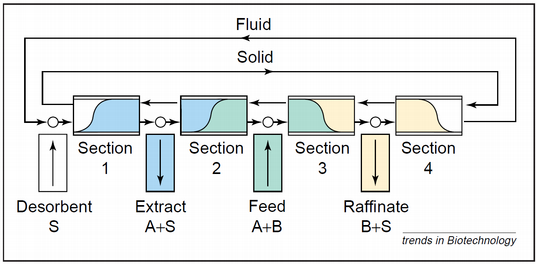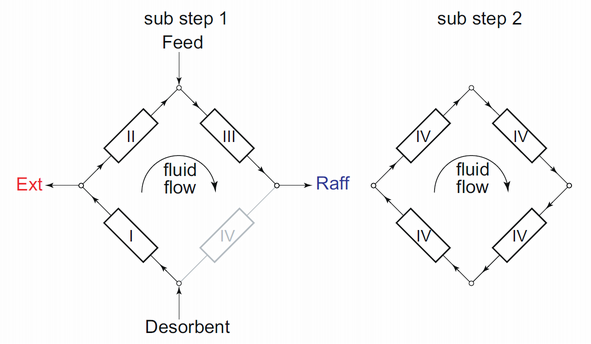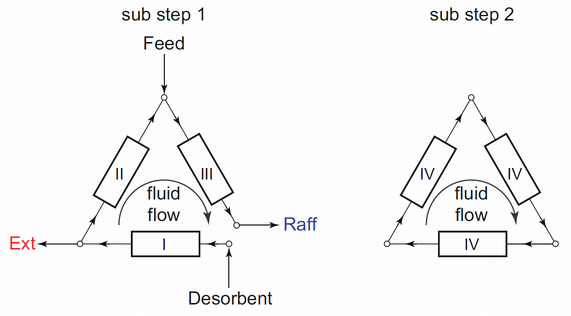Development of Simulated Moving Bed Processes
Simulated Moving Bed is a continuous chromatographic process developed in the second half of the 20th century. Offering improved productivity with respect to chromatographic batch processes, SMB (and advanced SMB-like processes) is conveniently used for the separation of sugars, fine chemicals, chiral substances and lately also biomolecules at production scale.
The basic principle of (simulated) moving bed chromatography is illustrated in Figure 1 [1]. Adsorbed and mobile phases are operated countercurrently, i. e. the adsorbed phase movement (in SMB simulated via valve switching) occurs in the opposite direction than the movement of the mobile phase. The separation of the two target components takes place in sections 2 and 3. In these sections, the (simulated) movement of adsorbed and mobile phase is tuned such that the net movement of the less retained component is in the direction of the mobile phase flow, whereas the net movement of the more retained component is in the opposite direction. Accordingly, the less retained component is collected in the raffinate, whereas the more retained component is collected in the extract. Regeneration of the adsorbed and the mobile phase takes place in sections 1 and 4, respectively.
Within the last decades, several modifications to SMB were developed in order to further enhance productivity and to enable different operating modes (e. g. the use of gradient solvents) as well as multicomponent separations. The intermittent simulated moving bed process (I-SMB) investigated in our group promises a considerable increase in productivity by a factor of 2 for the standard 4 column I-SMB process [2] and by a factor of 3 for the further modified 3 column I-SMB process [3], compared to the standard SMB process (1-2-2-1 configuration).
Figure 2 shows a scheme of conventional I-SMB consisting of four sections each comprising one chromatographic column. The switch time of the valves is divided into two sub steps; in sub step 1 the unit is operated as a standard SMB, however, without flow in section IV. In sub step 2, all inlet and outlet ports are closed and the fluid is just circulated through the column train in order to adjust the relative position of the concentration fronts.
As it was shown that roughly a quarter of the adsorbent being used in I-SMB is not active in separating the feed mixture, a further modification is studied, reducing the number of columns from 4 to 3. The 3C-ISMB process is illustrated in Figure 3. Comparing Figure 3 to Figure 2, we can see that sub step 1 exactly equals the corresponding sub step in standard I-SMB, whereas sub step 2 consists of only three instead of four sections. It was shown that 3C-ISMB could further boost productivity by 60% with respect to the standard I-SMB process. Apart from promising highly efficient binary separations [4], 3C-ISMB cascades are also considered as an interesting technique in the context of three-fraction separation [5].



References
- external page call_made 1. Juza, M.; Mazzotti, M.; Morbidelli, M. Trends Biotechnol. 2000, 18, 108-118
- external page call_made 2. Katsuo, S.; Mazzotti, M. J. Chromatogr. A 2010, 1217, 3067-3075
- external page call_made 3. Jermann, S.; Mazzotti, M. J. Chromatogr. A 2014, 1361, 125-138
- external page call_made 4. Jermann, S.; Alberti, A.; Mazzotti M. J. Chromatogr. A 2014, 1364, 107-116
- external page call_made 5. Jermann, S.; Meijssen, M.; Mazzotti M. J. Chromatogr. A 2015, 1378, 37-49